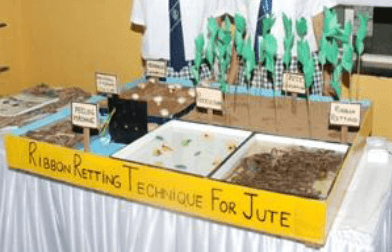Project Name: Ribbon retting-a cost effective and eco friendly technique for jute retting
Name of the Theme: Industry
Objective: To produce improved quality and cost effective jute with integrated Mushroom Cultivation and Pisciculture.

Scientific Principle:
1. Instead of stem retting process, ribbon retting is used as thin stripped ribbons of jute are much easier to ret than stems. Ribbon retting reduces time of normal retting by 4-5 days. Moreover, requirement of water for ribbon retting is almost half in comparison to conventional whole plant retting under normal condition. This also reduces environmental pollution to a great extent. But use of efficient pectinolytic microbial inoculums improves quality of fibre, further reduce the time of retting and the environment pollution.
2. The waste products of retting process is rich in cellulose and nitrogen, thus can be used as organic manure in the cultivation of mushroom.
3. The retting water is recycled by irrigating the jute fields with its.
Material Used: Wooden base, Tray, artificial jute plants, soil, mushroom, artificial fishes and an aluminum sheet with holes signifying retting machine
Working: Instead of conventional retting process, ribbon retting process is demonstrated in the model combined with mushroom cultivation and pisciculture in increase the overall profit of farmers and improve the quality of Jute.
In ribbon retting, ribbons are stripped out from the stem of mature jute plants, coiled and allowed to ret under water bodies which farmers can create artificially by digging a hole and filling it with small amount of water. Ribbon retting ensures the overall quality, texture, and color of jute.
Use of mixed bacterial cultures work as effective retting agents and help in reducing the time required as they have a measure of symbiosis.
The saprophytic fungus (Sporotricchum) is capable of retting dry ribbons of jute under laboratory conditions.
Lignocelluloses jute waste products viz. leaves, stick and caddis, can be used as substrates for the production of oyster mushroom due to their high cellulose and nitrogen content.
Retting-cum-pisciculture centre (CRPC) is demonstrated by the project. Fast growing cat fish can be raised to marketable size in four months-the period during which retting activities are undertaken. Retting is predominantly anaerobic and severe depletion of oxygen takes place, thus it has to restrict to air breathing species during retting time.
Cultivation of the edible Mushroom is another potential field of utilizing lingo cellulosic waste for which a variety of agricultural and forestry residues are used. The easy availability and low cost of lingo cellulosic biomass has made it an important substrate for Mushroom production.
Utility and Further Use of Project:
1. The ribbon retting method saves the farmers the cost of transporting jute to nearby water bodies as well as increased quantity of jute to be retted at a time than the conventional method.
2. This technique reduces dark coloring of fibres resulting from soil contamination and improves the poor retting practices which lowers the quality of fibres produced.
3. A number of low-cost bleaching agents like extracts from tamarind leaves, vinegar can be used.
4. In areas where there is shortage of retting waters, ribbon retting should be practiced.
5. The technique reduces water pollution.
6. Retting wastes can be used as a green manure, reduces handling and transport effort and thus lowers the costs.
7. Defoliation prior to retting in the field itself will reduce transport and increase the soil fertility.
8. Jute stick and caddies can be used in paper industry and biogas production.
Name of the School: Vidya Devi Jindal School, Delhi Road, Hissar (Haryana)
